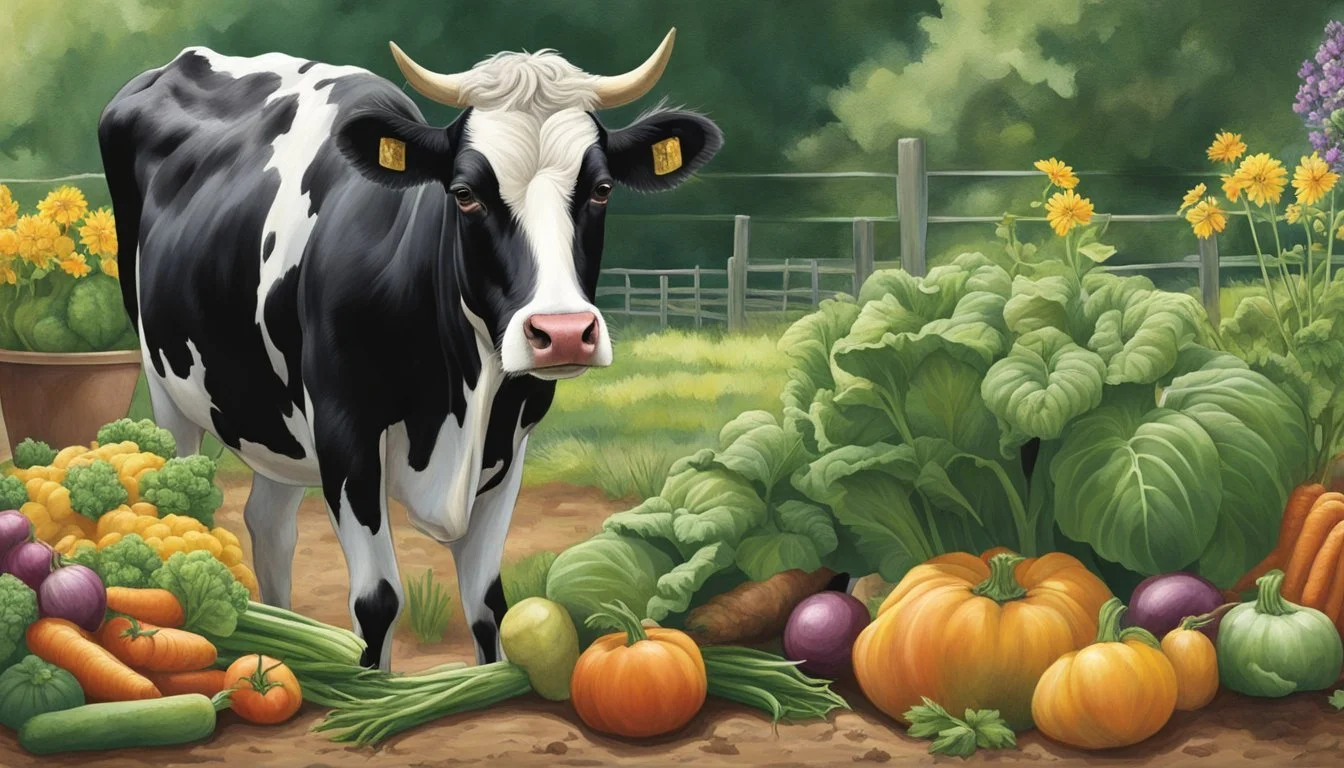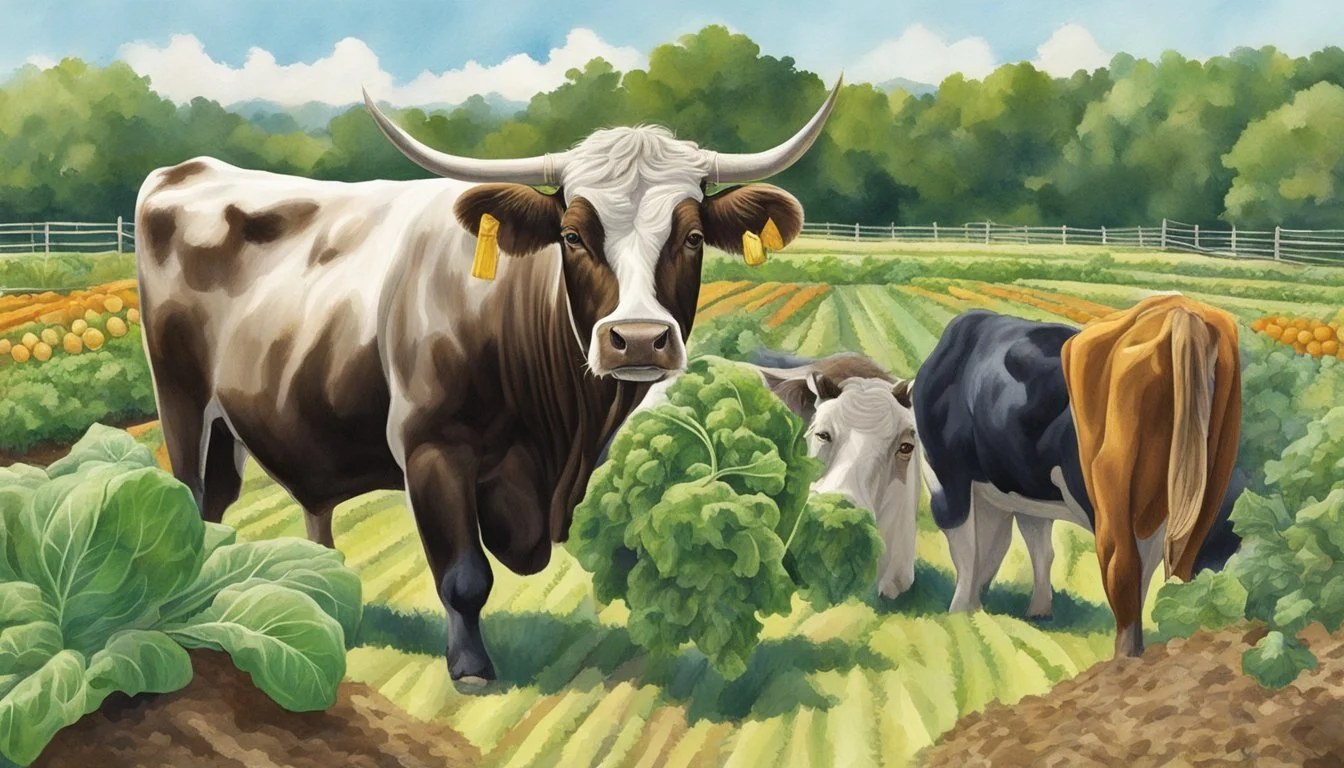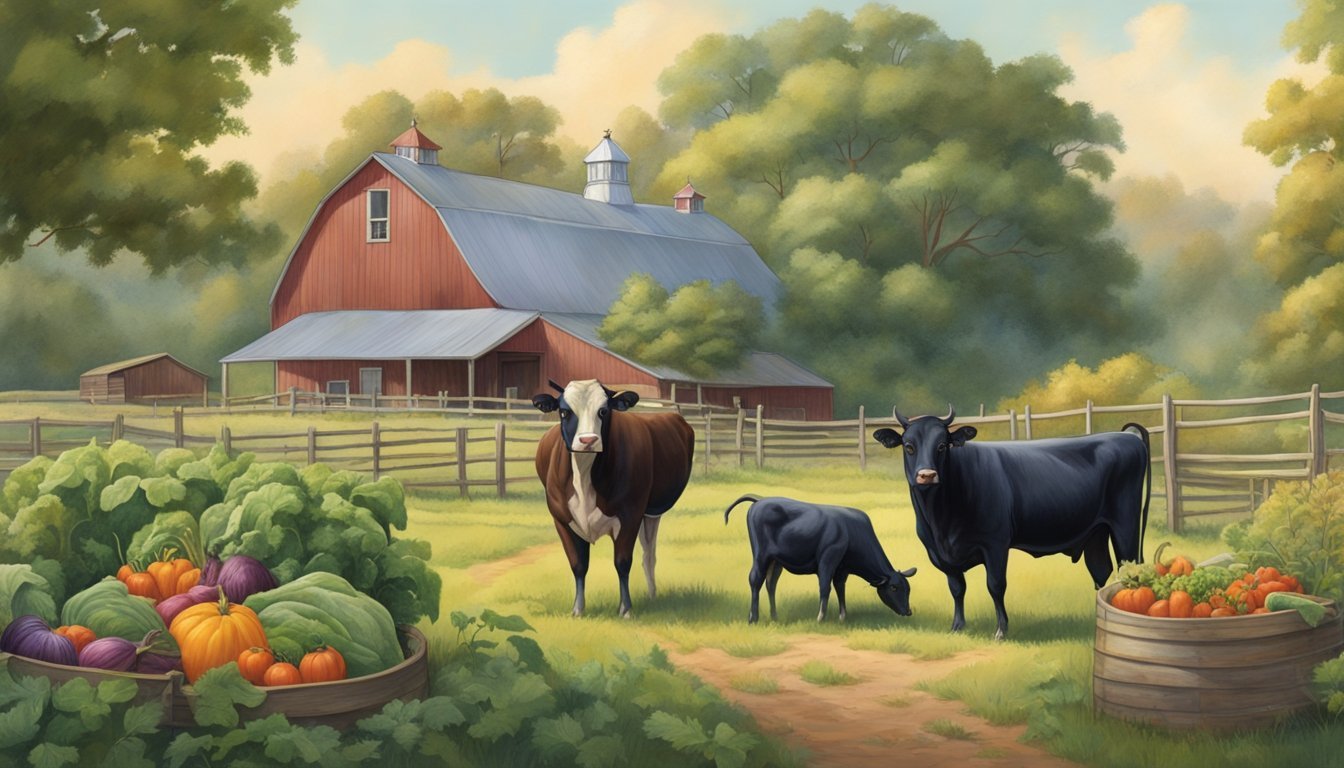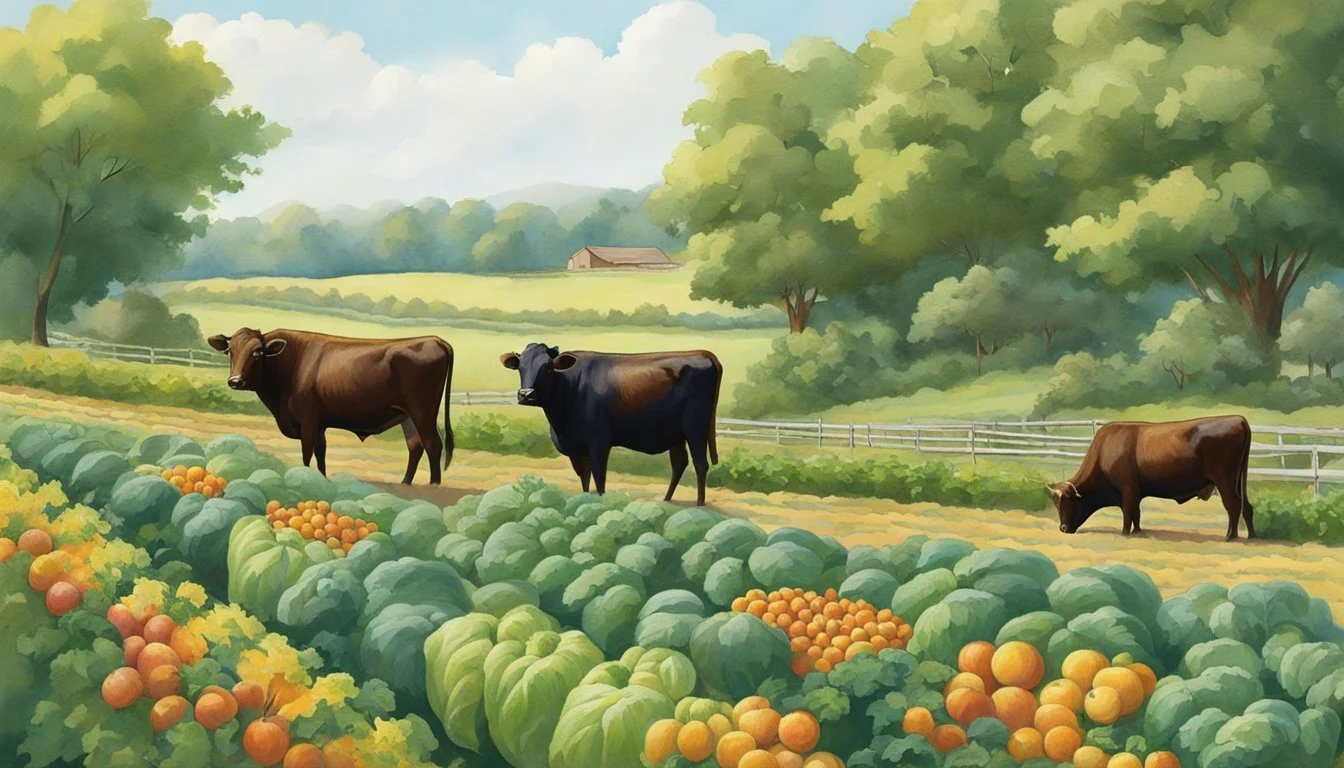Dexter Cattle and Heirloom Vegetables
Exploring Their Symbiotic Farming Benefits
Dexter cattle, a versatile and hardy breed known for its smaller size, are increasingly integrated into sustainable farming practices centered around heirloom vegetables. Heirloom vegetables, which are varieties that have been preserved for their unique flavors, nutritional value, and adaptability, thrive in environments where natural ecological practices are prioritized. The introduction of Dexter cattle into such systems highlights a symbiotic relationship, where the cattle contribute to the health and productivity of the vegetable crops while benefiting from the nutrient-rich byproducts of horticulture.
This relationship is rooted in the cattle's provision of natural fertilizer through their manure, which enriches the soil and promotes better vegetable growth. In turn, the heirloom vegetables offer a diverse diet for the cattle, which can improve their overall health and the quality of their meat and milk. Additionally, Dexter cattle, often being pasture-raised, help to manage the land by providing natural weed control and assisting in the maintenance of a healthy ecosystem, which is crucial for the sustainability of heirloom vegetable cultivation.
The integration of Dexter cattle with the cultivation of heirloom vegetables not only exemplifies a practical approach to farming but also embodies the principles of permaculture where each element supports others. This model of agriculture contributes to a closed-loop system, reducing waste and ensuring that both the cattle and the vegetable crops can sustain one another in a continuous cycle of mutual benefits.
Understanding Symbiosis
Symbiosis is a fundamental ecological interaction that significantly influences the survival and productivity of species. The dynamics of ecosystems are vastly shaped by these intricate relationships.
Defining Symbiosis
Symbiosis is the close and often long-term interaction between two different species. It is a broad term encompassing various types of relationships that have substantial impacts on the organism's way of life. It is not always equal in benefit, but it is typically essential for at least one of the symbionts.
Types of Symbiotic Relationships
Symbiotic relationships are categorized based on the nature of the interaction and the benefits or detriments incurred by the participants:
Mutualism: Both species benefit from the association.
Commensalism: One species benefits while the other is neither helped nor harmed.
Parasitism: One organism, the parasite, benefits at the expense of the other, the host.
Symbiosis in the Animal Kingdom
In the animal kingdom, examples of symbiotic relationships abound. Gut bacteria in ruminants like Dexter cattle facilitate digestion, exemplifying a mutualistic relationship. Meanwhile, cattle can spread seeds from the heirloom vegetables they consume, which is beneficial for plant reproduction.
Plant and Microorganism Symbiosis
Plants engage in various mutualistic relationships with microorganisms. Leguminous plants form symbiotic unions with nitrogen-fixing bacteria, which convert atmospheric nitrogen into a usable form for the plant. In return, the plant provides carbohydrates to the bacteria. This mutualistic bond enhances soil fertility and supports the sustainable growth of crops such as heirloom vegetables, which rely on rich, balanced ecosystems.
Dexter Cattle in Agricultural Ecosystems
Dexter cattle play a multifaceted role in agricultural ecosystems. Their distinct grazing patterns not only contribute to effective land management but also enhance biodiversity and engage in natural pest control.
Grazing Patterns and Land Management
Dexter cattle, due to their smaller size, are noted for their light-footed grazing habits. They tend to graze more selectively, which can prevent overgrazing and promote the growth of diverse plant species. Farmers often use them in conservation efforts, as their grazing can help maintain the balance between various grasses and wildflowers, which is crucial for a healthy ecosystem.
Benefits to Biodiversity
Dexter cattle indirectly support biodiversity by shaping the habitats for numerous other species. Their grazing creates microenvironments that attract a variety of animals, including birds and insects, which thrive on the diverse plant life and open spaces. The dung of Dexter cattle also serves as a rich nutrient source that improves soil quality, further supporting a wide array of plant and tree species, and fostering the growth of beneficial fungi like lichens.
Dexter Cattle and Pest Control
These cattle are allies in natural pest management. While grazing, they disturb insects, making them more accessible to cattle egrets and other predatory birds. This partnership exemplifies one of the many symbiotic relationships that enhance the agricultural ecosystem, aligning with sustainable practices and contributing to ecological balance. In addition, as grazers, they play a small but meaningful role in potentially mitigating climate impact through managed grazing practices that sequester carbon in the soil.
Heirloom Vegetables and Symbiosis
Cultivating heirloom vegetables plays a critical role in maintaining agricultural diversity and promoting ecological balance through symbiotic relationships within ecosystems.
Advantages of Cultivating Heirloom Species
Heirloom vegetables are valued for their genetic diversity, which often results in plants with greater resilience to environmental stressors. They hold a stable but varied genetic makeup that is the product of natural open pollination. This diversity not only contributes to the robustness of the plants but also to the richness of the soil in which they grow, supporting a healthy ecosystem.
Increased resilience: Adapts better to changing conditions and climates.
Preservation of history: Maintains agricultural traditions and cultivates biodiversity.
Heirloom Vegetables and Insect Partnerships
Insect pollinators, such as bees, have co-evolved with heirloom plants, forming essential symbiotic bonds. For instance, the bright colors and unique scents of heirloom tomatoes can attract specific pollinators which aid in their fertility. Moreover, their longstanding relationships with insects help maintain a balance within the ecosystem, as many other species rely on this interdependence to thrive.
Biodiversity: Attracts a variety of insects and supports a broader range of wildlife.
Pollination: Ensures the propagation of plants and food production.
Soil Health and Plant Symbiosis
Healthy soil is the foundation of productive agriculture and heirloom species can enrich the soil through symbiotic relationships with fungi and other soil organisms. Plants like clover and alfalfa form mutualistic associations with nitrogen-fixing bacteria, providing essential nutrients to themselves and subsequent plantings. This natural process limits the need for artificial fertilizers and promotes a more sustainable farming practice.
Nitrogen fixation: Clover and alfalfa add nitrogen to soil, benefiting other plants.
Root associations: Fungal networks associate with plant roots, enhancing water and nutrient uptake.
Dexter Cattle and Heirloom Vegetable Interactions
In the realm of sustainable agriculture, Dexter cattle play a pivotal role in enhancing the growth and health of heirloom vegetable gardens. Through effective manure management, strategic intercropping, and natural pest control, these small yet hardy cattle contribute to a dynamic and beneficial ecosystem.
Manure as a Soil Enhancer for Heirloom Vegetables
Dexter cattle produce manure rich in nutrients essential for the robust growth of heirloom vegetables. This organic matter, when composted and added to the garden soil, acts as a powerful soil enhancer. It provides nitrogen, phosphorus, and potassium—key elements necessary for the health of species such as tomatoes, beans, and peas. The addition of cattle manure also increases the presence of beneficial soil protozoa, which play a critical role in nutrient cycling.
Nutrient Content of Dexter Cattle Manure:
Nitrogen: Vital for leafy growth.
Phosphorus: Crucial for root and flower development.
Potassium: Essential for the overall vigor of the plant.
Intercropping Strategies and Animal Integration
The integration of Dexter cattle with heirloom vegetables can be optimized through intercropping strategies. Intercropping involves growing different species of plants together, such as beans, peas, and clover, in proximity to the cattle's pasture. This not only maximizes land use but also leads to a symbiotic relationship where the cattle feed on legumes like alfalfa, soy, and clover, which fix nitrogen in the soil, enhancing soil fertility for neighboring vegetable plots.
Examples of Intercropping Combinations:
Alfalfa or clover with tomato plants.
Soybean or peas adjacent to rows of dill and other flowering plants.
Pest Management in Heirloom Vegetable Gardens
Dexters contribute to the pest management in heirloom vegetable gardens indirectly. Their grazing promotes the health of flowering plants like clover, which attract beneficial insects such as bees. These pollinators not only improve the yield of food crops but also help maintain the balance by preying on or deterring common vegetable pests. Thus, Dexter cattle support the creation of a self-regulating ecosystem where the need for chemical interventions is minimized.
Pest Control Benefits:
Increased bee populations for pollination.
Healthy flowering plants that attract pest-predating insects.
Case Studies
This section provides a closer look at how specific symbiotic relationships contribute to the overall health of various ecosystems. The roles that species play in these interactions can range from providing essential nutrients to offering protection and enhancing biodiversity.
Cattle Egret and Cattle Symbiosis
Cattle egrets and cattle participate in a symbiotic relationship known as mutualism, where both parties benefit. Cattle egrets feed on the insects stirred up by grazing cattle, which in turn reduces the number of parasites that could harm the cattle. This interaction offers a clear example of how symbiotic relationships can aid in agricultural pest management.
Food: Insects
Birds: Cattle Egrets
Ecosystem: Grasslands, farms
Coral Reef Ecosystem Dynamics
The coral reef ecosystem is a complex, symbiotic environment with numerous interactions among its inhabitants. One of the most iconic is the mutualistic relationship between clownfish and sea anemones. Clownfish seek refuge among the sea anemone's nematocysts, which offer protection due to their stinging capability, in exchange for the removal of parasites from the anemone. The mucus on the clownfish's skin protects it from the anemone's sting. Meanwhile, the coral itself forms symbiotic relationships with algae, providing the necessary nutrients for the reef's survival.
Coral Reefs: Home to diverse symbiotic relationships
Symbiotic Relationships: Clownfish and sea anemones, coral and algae
Food: Plankton, algae
Leguminous Plants and Nitrogen Fixation
Leguminous plants like clover and soybean have a symbiotic relationship with bacteria known as rhizobia. These bacteria reside in nodules on the plants' roots and possess the unique ability to fix atmospheric nitrogen, converting it into a form the plant can use. This natural fertilizer supports the growth of the plants, which in turn provides a home and nutrients for the rhizobia, showcasing an efficient cycle of nitrogen fixation within ecosystems.
Leguminous Plants: Clover, soybean
Symbiotic Relationships: Rhizobia bacteria and leguminous plants
Ecosystem Benefits: Nitrogen fixation, soil fertility
Through these case studies, the delicate interdependencies that form within various ecosystems highlight the importance of symbiotic relationships for maintaining ecological balance and promoting diverse life.
Challenges and Considerations
In cultivating Dexter cattle alongside heirloom vegetables, farmers face several challenges and considerations. Achieving a balanced symbiosis is essential but can be disrupted by factors like climate change and human activities.
Maintaining Symbiotic Balance
Symbiotic relationships involve complex interactions between animals, plants, bacteria, fungi, and other organisms. With Dexter cattle and heirloom vegetables, one must carefully manage these interactions to ensure beneficial outcomes. Overgrazing by cattle can deplete soil nutrients necessary for plant health, while an imbalance can introduce parasitic entities that harm both plant and animal. Practices such as rotational grazing and intercropping can help maintain this equilibrium.
Impact of Climate Change on Symbiosis
Climate change poses a significant threat to the delicate balance within symbiotic relationships. For instance, increased temperatures and altered rainfall patterns can affect the growth of plants important for cattle feed, as well as the microorganisms which support soil health. Farmers must adapt by selecting drought-resistant vegetable varieties and implementing water conservation practices.
Human Activities and Symbiotic Disruption
Human intervention, through both direct and indirect activities, has the potential to upset the symbiotic dynamics between Dexter cattle and heirloom vegetables. The use of synthetic fertilizers and pesticides can be detrimental to soil microbiota, which in turn affects plant health. To minimize disruption, a concerted effort towards organic farming practices that encourage biodiversity and reduce chemical usage is paramount. This includes integrating natural pest control methods and favoring the use of composted manure over chemical fertilizers.
Conclusion
Dexter cattle and heirloom vegetables represent a paradigm of agricultural symbiosis. In their relationship, each entity plays a vital role that facilitates the well-being and sustainability of the farm ecosystem.
Dexter Cattle offer multiple benefits:
They provide manure, which is an excellent organic fertilizer, enriching the soil for heirloom vegetable cultivation.
Their grazing patterns can help control weed population, reducing the need for chemical herbicides.
Heirloom Vegetables contribute to this relationship by:
Supporting biodiversity with their unique and varied genetics.
Attracting beneficial insects that can provide natural pest control for the pasture where cattle graze.
In practice, integrating Dexters with vegetable farming can lead to a reduced carbon footprint, as the cycle of planting, tending, and harvesting aligns seamlessly with the natural behaviors and requirements of the cattle. Farmers reap the rewards of this interdependent relationship through enhanced soil quality, reduced input costs, and the market appeal of both high-quality, grass-fed beef and diverse, flavorful vegetables.
This model exemplifies the strength found in ecological cooperation and provides a blueprint for sustainable farming practices. By aligning with nature's inherent tendencies, farmers can establish a self-reinforcing system where the success of one component amplifies the success of the whole.







